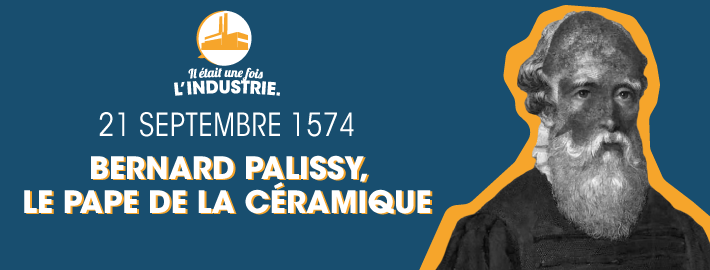GLOBAL
INDUSTRIE
News
Share on

21 SEPTEMBER 1574: Bernard Palissy, the father of ceramics
What happened this week in the History of Industry? It is to answer this question that Global Industrie invites you to rediscover, every week, a historical event which occurred around this time… in another age. At a time when ceramic is becoming one of the “new” materials increasingly prized in industry, let us pay tribute to its symbolic figurehead in France, Bernard Palissy, who, on the 21st of September 1574, was received in the Louvre by Catherine de Médicis to present his finest creations to her.
A MAN FIRED BY AN ALL-CONSUMING PASSION
Probably born in Agen around 1510, this self-taught artist of humble origins, blessed with exceptional strength and vitality, set up business as a glass painter in Saintes after completing the famous journeyman’s tour of France, a journey which enabled him both to perfect his art and to develop his taste for observing nature. He married and converted to Protestantism.
According to legend, his calling as a potter arose by chance around 1539 when he was shown an Italian enameled earthenware cup. He was apparently so dazzled by the brilliance of its shimmering colors that he immediately decided to give up glass painting for pottery and devote himself to researching this technique and the secret of white enamel. In reality, it was apparently more likely a piece of Chinese porcelain, but no matter. The fact is that he dedicated himself passionately and relentlessly to this quest, which was to take up no less than 16 years of his life.
In one particularly famous episode, finding himself one day short of wood to maintain the fire in the kiln in which several of his pieces were being fired, he did not hesitate to smash the table and chairs in his dining room and tear up and burn his floorboards to fuel the fire. Needing at the same time to feed his wife and six children, he worked simultaneously as a land surveyor. This work enabled him to travel through the Saintonge salt marshes and maintain his second passion: observation of the fauna and flora from which he drew inspiration to decorate his creations.
THE DAY OF GLORY (FINALLY) ARRIVES!
This persistence eventually paid off. By 1555, he had succeeded in mastering the production of enamels and began to produce the famous crockery for which he was to become renowned, particularly his "rustic basins", large platters decorated with animals and shellfish in relief, and his enameled pottery, the "figulines", adorned with animals and plants naturally molded on dishes and vases covered with glossy glazes.
It was then that he made the acquaintance of the Constable of France, Anne de Montmorency, who hired him to produce, among other things, in his Château d'Écouen, which still today houses some of his finest works, a grotto with ceramic decorations representing marine plants and animals. He was introduced by him to the Queen Mother Catherine de Médicis, who invited him, in 1566, to work on the decoration of the new Tuileries Palace. Thanks to this royal protection, he escaped the Saint Bartholomew’s Day Massacre in 1572, but was briefly forced to leave Paris. When he returned, he also gave lessons… in paleontology and natural history, keenly followed by many savants and scholars. Indeed, to decorate his potteries in an original way, he collected all sorts of fossils which he studied carefully, writing two books on them which upset a number of scientific theories of the time. As the great scientist Fontenelle was to write more than a century later, “this potter who knew neither Latin nor Greek was the first to dare to say that fossil shells were shells deposited in the past by the sea". During this period he also wrote his "Admirable Discourses", a chapter of which is devoted to his experience as a potter, and created a "cabinet of curiosities", a forerunner of future natural history museums, to show off his discoveries.
It was thus a true Renaissance man who was received by Catherine de Médicis at the Louvre on the 21st of September 1574 and who presented to her several of his finest creations.
A VICTIM OF THE WARS OF RELIGION
In spite of this, the end of his life was particularly sad. In 1586, he was imprisoned for his religious convictions. Ordered to convert, the old man, now over 75 years old, refused to bow. A forceful personality, he was sentenced to be banished… but stayed in Paris. Arrested again in May 1588, he was sentenced to death, appealed, and had his sentence commuted to life imprisonment. Jailed first in the Conciergerie and then in the Bastille, he died there in 1589 or 1590, a victim of hunger, cold and ill-treatment.
His legend was born upon his death, dramatized by contemporary chroniclers as eminent as Agrippa d'Aubigné. Enlightenment thinkers and revolutionaries in particular were later to see him as the archetypal genius persecuted by the Church. His writings on hydrology and agriculture, which were ahead of their time, were censored but continued to circulate secretly before being republished in the 18th century.
"I’d rather tell the truth in my rustic language than lies in a theoretical language" – Bernard Palissy
2020.09.21